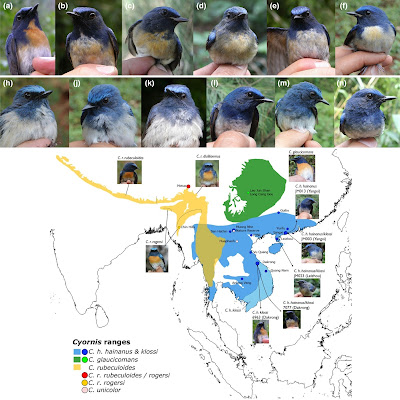 |
in Ng, Li, Zhang, Garg, ... et Lei, 2022. DOI: 10.1111/zsc.12568 |
Abstract
Morphology has been a leading taxonomic guiding light to systematists for the last couple of hundred years. However, the genetic and – more recently – genomic revolution have produced numerous demonstrations of erroneous classifications that were based on labile morphological traits. We used thousands of genome-wide markers to shed light on evolutionary dynamics in a confusing and taxonomically obscure group of Asian Cyornis flycatchers. Using genomic data, we corroborated recent findings based on three mitochrondrial and five nuclear genes that the two taxa hainanus and klossi which were previously treated as separate species (Cyornis hainanus and Cyornis rubeculoides klossi, respectively) are genomically homogeneous and form a single species, C. hainanus. We also uncovered a novel case of interbreeding between C. hainanus and a non-sister species, C. glaucicomans, illustrating these flycatchers' ability to hybridise in marginal situations even after substantial times of divergence. Our study illustrates how genome-wide loci can shed light on complicated taxonomic problems, resulting in a better integration of phenotypic and genotypic data.
Keywords: Cyornis, ddRADseq, introgression, phylogenetics, species complex
CONCLUSIONS:
The classification of Cyornis flycatchers has undergone substantial change over the last two decades, resulting in taxonomic rearrangements, in particular the synonymisation of the genus Rhinomyias with Cyornis (Sangster et al., 2010; Zhang et al., 2016; Zuccon & Ericson, 2010). Our study demonstrates that population-genomic and phylogenomic methodologies can effectively be applied to disentangle the complicated evolutionary history of cryptic species complexes such as the Cyornis flycatchers. Our ddRADseq data set confirms the remarkable case of incongruence between plumage and genomic divergence that has misled previous taxonomists into erroneous classifications (Zhang et al., 2016). Our results also show a novel interbreeding event between two non-sister species.
Elize Y. X. Ng, Siqi Li, Dezhi Zhang, Kritika M. Garg, Gang Song, Jonathan Martinez, Le Manh Hung, Vuong Tan Tu, Jérôme Fuchs, Lu Dong, Urban Olsson, Yuan Huang, Per Alström, Frank E. Rheindt and Fumin Lei. 2022. Genome-wide SNPs confirm Plumage Polymorphism and Hybridisation within A Cyornis Flycatcher Species Complex. Zoologica Scripta. DOI: 10.1111/zsc.12568
• Using genome wide markers, our study confirmed that 𝘊𝘺𝘰𝘳𝘯𝘪𝘴 𝘩𝘢𝘪𝘯𝘢𝘯𝘶𝘴 𝘬𝘭𝘰𝘴𝘴𝘪 was the same species as 𝘊. 𝘩. 𝘩𝘢𝘪𝘯𝘢𝘯𝘶𝘴.
• Based on plumage alone, 𝘊. 𝘩. 𝘬𝘭𝘰𝘴𝘴𝘪 was historically placed in the same species as 𝘊. 𝘳𝘶𝘣𝘦𝘤𝘶𝘭𝘰𝘪𝘥𝘦𝘴.
• Furthermore, in the same study, we also uncovered the first reported instance of hybridization between 𝘊. 𝘩𝘢𝘪𝘯𝘢𝘯𝘶𝘴 and 𝘊 𝘨𝘭𝘢𝘶𝘤𝘪𝘤𝘰𝘮𝘢𝘯𝘴




